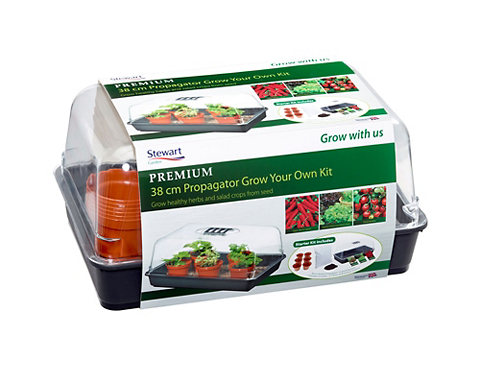How to use a propagator to grow seeds
Give your seeds the best start in life using a propagator
Growing your own plants right from the seed is a rewarding way to get your garden looking full of life. Using a propagator means you’ll be able to kick start seeds into germination earlier in the season by providing them with a stable growing environment.

When seedlings are young, they’re more vulnerable to being damaged by changes in temperature and moisture. If you sow your seeds in a propagator, you’re giving them a much better chance at survival.
A propagator is like an incubator for your seeds, a mini greenhouse made of plastic, with vents so you can manage the temperature inside.
In this guide, we’ll be teaching you how to sow seeds in an unheated propagator. You can also buy heated propagators, which will plug in and rise to the temperature you need, and keep it consistent whilst the seed is germinating.
You might need:
Choosing your seeds
If you’re a beginner, you’ll want to choose something that’s easy to start with. We’d recommend:
- Tomatoes
- Runner beans
- Chillies
- Sweet peas.
Top tip
Growing pockets are a great option for smaller seeds, and you won’t need to worry about messy compost. These are made from compressed compost ideal for germination. Each pocket has a hole for your seed, and when it’s watered it’ll expand to fit the space in your seed tray.
When to plant your seeds
Sowing your seeds indoors means you can start off your plants earlier than what's guided on the packet, which helps you extend your growing season. Some you can start as early as January using this technique, such as sweet peas.
Sowing your seeds in a seed tray and propagator
Step 1: Fill a seed tray with seed and cutting compost, then level the surface by running a piece of wood over it to scrape off the excess. Using a tamper, gently tamp down the compost to level the surface.
Step 2: Depending on the size of your seeds, you’ll either need to sprinkle them in a thin layer on top or push them in one by one if they are bigger. Your seed packet will give you full sowing instructions, such as what depth to plant them at, and how far apart they should be, so it’s a good idea to give these a read before you start.
Step 3: Sieve compost over the seeds so they lie at the correct depth below the surface. If you’re growing more than one type of seed, label your trays so you know what’s growing and check their progress against their growing instructions
Step 4: Using a watering can with a rose head, gently water the seeds in. Alternatively, you can stand you seed tray in a shallow tray of water. This draws the seeds down into the compost, instead of washing them out, which a watering can may do.
Step 5: Place your propagator somewhere warm, but not in direct sunlight if you can help it. A sunny window sill will do – but take care to turn it regularly, or the seedlings will grow towards the light and become weak and spindly.
Top tip
Some seeds need soaking overnight before you plant them. The package will tell you how to prepare your seeds.
How many seeds to plant
Sow seeds sparingly. More seeds die from being overcrowded than for any other reason. Even if they all germinate, competition from densely crowded neighbours will keep them from growing properly, and they will either die or become leggy as they struggle to grow taller than the others.
What’s more, seeds sown too thickly are vulnerable to ‘damping off’, a fungal disease caused by lack of air circulation, too much water and not paying attention to hygiene – using dirty containers or re-using old compost are common mistakes.
Where two plants germinate in one module, pull out the smaller one and dispose of it, ideally in your compost bin.
Top tip
When choosing which compost to use in your propagator, make sure you buy seeding compost. Normal compost is too rich and doesn’t have the right texture to allow for enough oxygenation and drainage.
We recommend using peat-free compost, as peatlands are vital in helping to protect natural habitats and tackle climate change. Find out more about our peat-free proposition here.
We think you'll love...
Caring for your seedlings
There are three key elements your seeds need to germinate successfully are:
- Enough light
- Enough water
- Kept at the right temperate
Light
To give your seeds the best environment to grow in, your propagator is best placed:
- In natural daylight for as many hours as possible
- Rotate your propagator regularly to prevent your seedlings growing towards the light
Moisture
The compost needs to be:
- Moist but not soggy, if it’s too wet this could lead to rotting or fungus developing on your seeds
- Left to dry slightly between watering
- Some propagators also have a capillary wetting matt under the pots, allowing the seedlings to draw up water when they need it.
- You should check your propagator every day, and if the compost is drying out, give your seeds a drink
Temperature
You need to keep your seedlings:
- Somewhere warm, and draft free
- Between 18 and 25 degrees (check your seed packet for specific instructions). Use a thermometer to take the soil temperature.
Transitioning your seedlings outside
When you're seedlings are strong enough, you can transition them to their permanent home outside. Read our guide for all the information you need to be successful.








